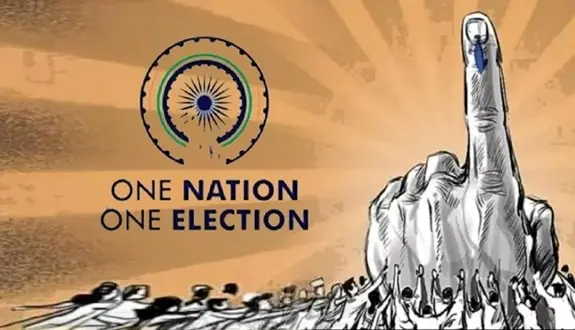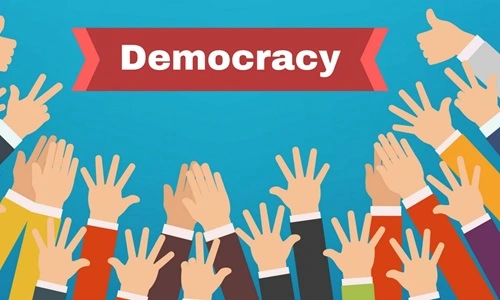India, being the largest democracy in the world, conducts elections at various levels, including for the Lok Sabha (Parliament), State Legislative Assemblies, and local bodies. Over the years, elections have become an integral part of the country’s political fabric, with different states having their own election cycles. However, the Government of India has been discussing the idea of “One Nation One Election” (ONOE) — a system where simultaneous elections are held for both the Lok Sabha and State Assemblies. This proposal has sparked debates, with supporters hailing its potential benefits and critics pointing out its challenges.
In this article, we will do a deep dive into the idea of One Nation One Election, analyzing its advantages and disadvantages, to help Indians better understand the implications of such a significant change in the electoral process.
What is One Nation One Election?

One Nation One Election refers to the concept of holding all elections for the Lok Sabha, State Legislative Assemblies, and possibly local bodies simultaneously across India. Currently, elections are held at different times based on the completion of the term for each legislative body. This leads to frequent election cycles across the country. The idea of simultaneous elections is not entirely new; India conducted simultaneous elections for the Lok Sabha and State Assemblies from 1951 to 1967. However, political instability in several states led to mid-term elections, disrupting the cycle.
In recent years, the government has revived discussions on this issue, proposing that holding elections simultaneously could bring about a range of benefits. Let’s explore the advantages and disadvantages of One Nation One Election.
Advantages of One Nation One Election
1. Cost Efficiency
One of the primary arguments in favor of One Nation One Election is the reduction in election-related expenditure. Conducting elections frequently across various states incurs a huge financial cost for the government, political parties, and even the public. From deploying security personnel, managing polling stations, printing ballots, and ensuring logistics, the process involves substantial resources.
With simultaneous elections, the cost incurred by the Election Commission and state governments would be reduced significantly. Political parties would also spend less on campaigning since they would only have to mobilize their resources once for both national and state elections.
2. Reduced Disruption in Governance
Frequent elections often lead to the imposition of the Model Code of Conduct (MCC), which restricts the government from making major policy decisions. This hampers the development agenda and delays crucial projects. Under the current system, with some state elections happening every few months, the MCC is in place for significant periods, disrupting governance.
One Nation One Election would minimize this disruption, allowing governments to focus more on governance and development rather than being in a constant state of election preparation.
3. Increased Voter Turnout
Simultaneous elections could potentially lead to a higher voter turnout, as people would be casting their votes for both national and state elections in a single go. This might encourage more citizens to participate in the electoral process, particularly those who might otherwise not engage with state elections held separately.
By consolidating elections, voters may feel more compelled to exercise their democratic rights in a comprehensive manner, thereby strengthening the overall electoral process.
4. Consistency in Development Plans
Simultaneous elections may lead to more consistent development policies across the country. Currently, the results of state elections sometimes differ significantly from the national election results, leading to political instability or conflicting policies between the Centre and the states. With One Nation One Election, the alignment of national and state government policies could be smoother, enabling faster implementation of projects and schemes.
5. Curbing the Politicization of Bureaucracy
Frequent elections put immense pressure on the bureaucracy, which is involved in the execution of elections. This often leads to a politicized environment where government officers have to balance between governance and electoral duties. One Nation One Election would reduce the frequency of this stress on the system and allow bureaucrats to focus more on governance than elections.
Disadvantages of One Nation One Election
1. Risk of National vs. Local Issues Overlap
A major concern with One Nation One Election is that national issues might overshadow local or regional concerns. During simultaneous elections, voters may be more focused on national issues and the performance of the central government rather than the specific issues affecting their state or local area.
This could lead to a situation where regional parties or state-level issues receive less attention, which might not reflect the true will of the people at the state level. For instance, a voter might want to support one party for national leadership but another for local governance, and a simultaneous election might force them to compromise.
2. Logistical Challenges
India is a vast and diverse country with over a billion people, and conducting simultaneous elections across all states would pose massive logistical challenges. Managing security, polling booths, voting machines, and personnel for both national and state elections at the same time would be a daunting task for the Election Commission.
In case of any mid-term dissolution of a state assembly or the national government, the synchronized election cycle would be disrupted. Reintroducing a simultaneous election cycle after such disruptions could lead to even more complexity.
3. Impact on Federalism
India is a federal country where states have their own powers and responsibilities. The current system of staggered elections allows state governments to remain accountable to their voters independently of the central government’s performance. With simultaneous elections, there is a risk that the importance of state elections might diminish, leading to a weakening of the federal structure.
States with regional issues might feel marginalized if voters are more focused on national concerns during simultaneous elections, which could undermine the essence of cooperative federalism.
4. Increased Political Instability
Currently, if a state government falls, elections are conducted only for that state, without affecting the rest of the country. However, in a One Nation One Election scenario, a state government collapse could lead to either a long period of President’s Rule or the need for a re-election in that state, disrupting the synchronized cycle.
This would create political instability, as governments may be hesitant to take tough decisions towards the end of their term, fearing that it could lead to simultaneous elections across the country. It also puts additional pressure on political parties to maintain their electoral momentum nationwide.
5. Challenge for Regional Parties
One Nation One Election could disproportionately benefit national parties like the Bharatiya Janata Party (BJP) and the Indian National Congress (INC), which have more resources and visibility. Regional parties, which often rely on state-specific issues and a more localized approach to campaigning, could find it difficult to compete in a scenario where national parties dominate the discourse.
Regional parties might struggle to communicate their specific agendas when voters are simultaneously considering national and state issues. This could lead to a reduction in the diversity of political voices, which is a hallmark of India’s democracy.
Conclusion
The idea of One Nation One Election in India comes with its set of both advantages and disadvantages. While it could bring significant cost savings, reduce election fatigue, and provide better governance continuity, it also raises concerns about logistical challenges, the overlap of national and state issues, and the impact on federalism.
For such a major electoral reform to be implemented, it would require constitutional amendments and the consensus of various stakeholders, including political parties, state governments, and the Election Commission of India. While the benefits are clear in terms of cost and governance, the potential downsides, especially concerning regional representation and political stability, need to be carefully considered.
As the debate continues, it is important for citizens to understand both sides of the argument. One Nation One Election has the potential to transform India’s democratic processes, but it is crucial to ensure that any changes made to the electoral system uphold the core values of India’s diverse and federal democratic structure.


